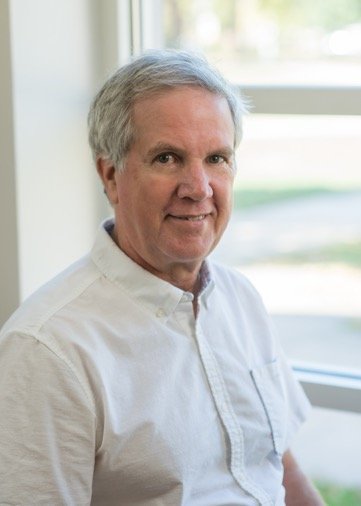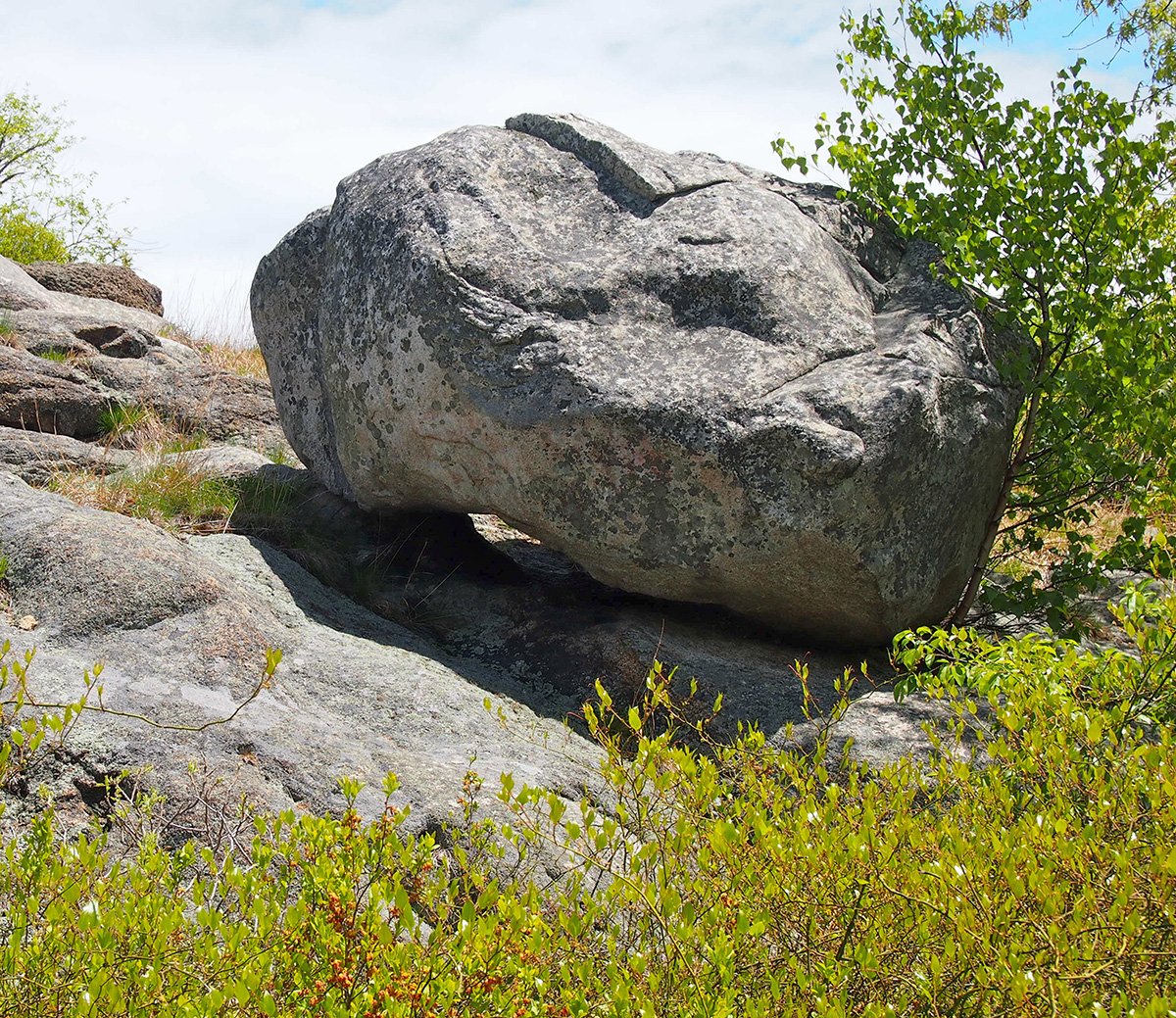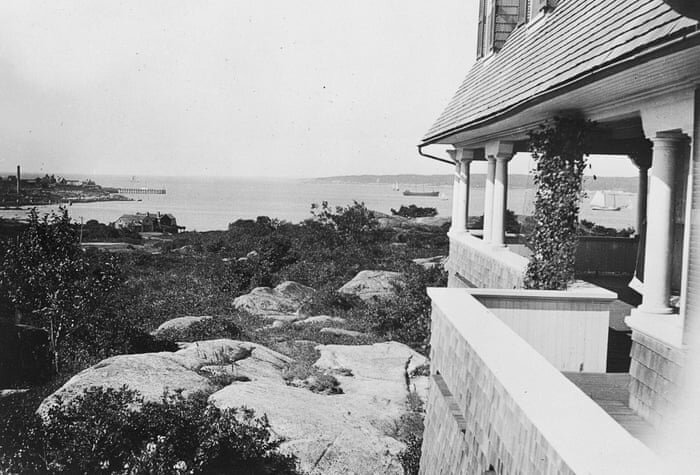Charles Olson, Maximus of Gloucester
Charles Olson, digitally manipulated photograph by Paul Cary Goldberg.
By Gary Grieve-Carlson
July 5, 2023
Charles Olson left a large footprint in Gloucester, with his stature of 6’8” far exceeded by the size of his poetic voice which arose from this city. Olson’s life, from the earliest to the final years, was enmeshed in Gloucester, which inspired many of his most important works.
His presence here persists in the annual Charles Olson Lecture sponsored by the Gloucester Writers Center, in the Maud/Olson Library at the Cape Ann Museum (this includes copies of all the books Olson is known to have owned, along with his marginal notes), and a small plaque at 28 Fort Square, where he lived in the upstairs apartment.
Olson also became a staunch defender of the soul of Gloucester and is remembered for his ardent support for its preservation. Those who knew him remember his tenacity, his struggles, his sudden generosity, and the conversations with friends at his kitchen table extending late into the early hours of the morning. He was the central figure in a legendary time of literary activity in Gloucester. No history of cultural life in Gloucester would be complete without acknowledging this giant of poetics and true friend and advocate for Gloucester.
His reputation extends worldwide with his work often included in anthologies, among the other major figures in mid-twentieth-century American poetry.
Wesleyan, Harvard, and Franklin D. Roosevelt
Charles Olson (1910-70) was born in Worcester, Massachusetts, where his father was a mail carrier. In the summer of 1915, the family began spending summers in Gloucester, renting a cottage on Stage Fort Avenue. They eventually leased the cottage, which became the mother’s permanent home after the father died in 1935, and a fixed point in Gloucester for Charles. He even worked in the summers as a letter carrier for the Gloucester Post Office.
Charles Olson, senior portrait, Wesleyan University, ca. 1932. Courtesy of University of Connecticut, Charles Olson Research Collection.
His literary aptitude flourished in high school where he became a champion orator, winning a tour of Europe and a meeting with William Butler Yeats. After earning B.A. and M.A. degrees in English from Wesleyan University, Olson tracked down Herman Melville’s copies of Shakespeare, including Melville’s marginal comments. In September 1936 he entered Harvard’s Ph.D. program in English and seemed headed for a career in university teaching. His essay “Lear and Moby-Dick” (1938), laying out Shakespeare’s seminal influence on that great novel, earned him a Guggenheim fellowship for further research in 1939.
But Olson’s interests were shifting. After one year in Harvard’s English program, he transferred to the school’s newly created program in American Civilization, where he completed the Ph.D. coursework but never wrote a dissertation. In 1940 he moved to New York, where he worked for the American Civil Liberties Union. He then moved on to Washington DC in 1942, working for the Office of War Information and the Democratic National Committee, where he was heavily involved in Roosevelt’s 1944 re-election campaign.
Literary Redirection and Black Mountain College
During this time Melville was still on his mind and Olson wrote Call Me Ishmael (completed in August 1945, published 1947). This book was not the sober, scholarly monograph an English professor would typically produce. Part One begins, “I take SPACE to be the central fact to man born in America, from Folsom Cave to now. I spell it large because it comes large here. Large, and without mercy,” And the wild ride spins out from there: the economics of the whaling industry, Homer and myth, the Bible, Freud, the wreck of the whaleship Essex. Call Me Ishmael made clear that Olson’s future was not in politics but in literature, and more specifically in a kind of literature that nobody else was writing.
In 1948 Olson accepted a position as visiting lecturer at Black Mountain College. Located in western North Carolina, the avant-garde college included painters Cy Twombly and Robert Rauschenberg during Olson’s time there. Among the school’s faculty were the artists Josef and Anni Albers, Franz Kline, and Robert Motherwell, the musicians John Cage and Stefan Wolpe, the dancer Merce Cunningham, and the designer Buckminster Fuller, who erected one of his first geodesic domes on the campus. Olson’s position at Black Mountain became full-time in 1951, and he was appointed Rector in March 1954. At that point the College, which had been struggling financially for some time, was in increasing difficulty, and Olson supervised its closing in 1957.
Projective Verse Splits with Establishment Poetry
Charles Olson, 1957. Photograph by Harry Redl. Courtesy of University of Connecticut, Charles Olson Research Collection.
Despite its financial hardships, Black Mountain was a source of tremendous intellectual and creative activity for both students and faculty, right up to the end. In 1950, Olson published his first important poem, “The Kingfishers,” and his most influential essay, “Projective Verse,” a manifesto marking the beginning of a split between American avant-garde and “establishment” poetry that would persist through at least the next twenty years. Olson became the informal leader of the “Black Mountain School” of poetry, a group that included Robert Creeley, Robert Duncan, Denise Levertov, Ed Dorn, Hilda Morley, and Larry Eigner (of Swampscott, Massachusetts). The group’s influence extended as well to such poets as Canada’s Daphne Marlatt and the U.K.’s J. R. Prynne. When Don Allen published his influential The New American Poetry: 1945-1960 (1960), none of the avant-garde poets in his anthology had appeared in the major existing anthology of contemporary poets, Donald Hall’s New Poets of England and America (1957), which focused on “establishment” poets such as Robert Lowell and Elizabeth Bishop. And so, the battlelines were drawn: Black Mountain, the Beats, the New York School, and the San Francisco Renaissance on one side; Lowell, Bishop, and others who were receiving official critical approval on the other.
Return to Gloucester and The Maximus Poems
After closing Black Mountain College, Olson moved in the summer of 1957 with his wife and son to the upstairs apartment at 28 Fort Square, Gloucester. The city had been on his mind for some time. In 1950 he wrote a poem called “I, Maximus of Gloucester, to You,” which spurred a series of poems, many of them written as “letters,” from a speaker called Maximus to the city. Most of these were written at Black Mountain, and the first ten were collected and published in 1953 as The Maximus Poems, 1-10. In 1956 The Maximus Poems, 11-22 followed, and in 1960 the two earlier volumes were collected with new Maximus poems in a single volume simply titled The Maximus Poems.
As the series unfolded, the “Maximus” persona and the “letter” device became less prominent, but the centrality of Gloucester persisted, even in the poems Olson wrote in the 1960s, published as Maximus IV, V, VI (1968) and The Maximus Poems, Volume 3 (1975). Olson refers to places—Main St, Pleasant St, Dogtown, the Cut, Stage Fort Park, the Parsons-Morse House—as well as to individual people, to local politics, and to the city’s history. The Maximus Poems are Olson’s life’s work, and they stand with Williams’s Paterson, Pound’s Cantos, and Hart Crane’s The Bridge as the major twentieth-century American poems in the epic or “long poem” tradition. As Olson’s series unfolds, we find elements of autobiography, American history, mythic material from Greek, Norse, Native American, and other traditions, and ancient Near Eastern history. The mode is sometimes hortatory or didactic, sometimes meditative, sometimes lyrical, but most often discursive. For readers unused to modern or avant-garde poetry, the poems can at times seem difficult or opaque. References are often unexplained, and grammar is sometimes fragmented.
Charles Olson in Buffalo with Allen Ginsberg at Warren Tallman's house, Summer 1963. Photograph by Karen Tallman. Courtesy of University of Connecticut, Charles Olson Research Collection.
A City Between Polis and Pejorocracy
Among scholars and poets, however, Olson’s significance is clear. His work is the subject of dozens of books and essays, and panels on his writing are held every year at major conferences around the country. He was the opening writer in Don Allen’s New American Poetry anthology, as well as the opening writer in the first and second editions of Postmodern American Poetry: A Norton Anthology (1994, 2013). No account of mid-twentieth-century American poetry can be complete without serious attention to Olson.
In the first volume of the Maximus Poems Olson uses two terms, “polis” and “pejorocracy,” as the polar opposites of what the city at its best could be, and what the city at its worst might be (“polis” is of course the ancient Greek city-state, and “pejorocracy” is a term coined by Ezra Pound meaning roughly “the rule of the worst”). At various times, each term seems to describe Gloucester for Olson. He is furious when urban renewal leads to the destruction of beautiful old buildings, or when profit seems to outweigh any other values. But he loves the way the light moves up a particular street at a particular time of day, or the view of the harbor from his second-floor apartment’s windows. He is interested in everything--history, gossip, stories—and he was a tremendously gifted letter writer. His letters to and from the poet Robert Creeley fill ten volumes, and many have yet to be published.
Although much of Olson’s writing can be difficult, not all of it is. His poem “Maximus, to himself,” from the first Maximus volume, is a good one for readers new to his work, as are his memoirs of his childhood, “Stocking Cap” and “The Post Office.” Henry Ferrini’s documentary film Polis Is This is a beautiful introduction to the man and his work. Two excellent essays on Olson are Peter Anastas’s introduction to his book Charles Olson: Maximus to Gloucester, The Letters and Poems of Charles Olson to the Editor of the Gloucester Daily Times, 1962-1969 and David Rich’s introduction to his book Charles Olson: Letters Home, 1949-1969.
Gloucester, Ultimately a Form of Mind
Charles Olson with Ezra Pound at Spoleto, July 1965. Courtesy of University of Connecticut, Charles Olson Research Collection.
In his introduction, Peter Anastas quotes from a draft (published posthumously in a scholarly journal) in which Olson writes of Gloucester: “She is still a place to go fishing from. She is still le beauport. She is a form of mind.” To the first Europeans who reached Cape Ann, Gloucester was above all an excellent “place to go fishing from.” Samuel de Champlain called Gloucester Harbor “le beauport” on the early seventeenth-century map he drew of the New England coast. A “form of mind” is perhaps what draws Olson back to Gloucester, and perhaps what he imagines its “polis” can nurture: a way of living in the world, a way of paying attention, a community that inspires creativity, friendship, and good work. After he returns to Gloucester in 1957, although he teaches briefly in Buffalo and Connecticut, he never gives up that Fort Square apartment. He forms lasting friendships in Gloucester with writers like Vincent Ferrini, Peter Anastas, Jonathan Bayliss, Joseph Garland, and Gerrit Lansing. And when the light, the air, and the company are just right, when the city is at her best (and when Olson is at his best), he is at his most expansive and generous. He tells the Beat poet Gregory Corso that Gloucester is a “redeemable flower that will be a monstrance forever, of not a city, but of City.” And in a wonderful conversation with the journalist Herb Kenny (recorded in the book Muthologos, a collection of Olson’s lectures and interviews), when Kenny says to Olson, “Well, Charles, what do you think the future of Gloucester on Cape Ann will be?” Olson replies without hesitation, “An image of creation and of human life for the rest of the life of the species.”
Written when Olson was 42 and reflecting on his life, the poem "Maximus, to himself," opens:
"I have had to learn the simplest things
last. Which made for difficulties.. . . I stood estranged
from that which was most familiar."
And it ends as he looks ahead:
"It is undone business I speak of, this morning,
with the sea
stretching out
from my feet."
Gary Grieve-Carlson is Professor of English Emeritus at Lebanon Valley College in Annville, Pennsylvania. He has published on Charles Olson, Robert Frost, Emily Dickinson, and Henry David Thoreau, among others, He serves on the Board of Gloucester's Jonathan Bayliss Society and is a friend of the Gloucester Writers Center. At various points in his life, he has lived in Connecticut, in Maine, on Cape Cod, in Boston, and in Beverly.


















